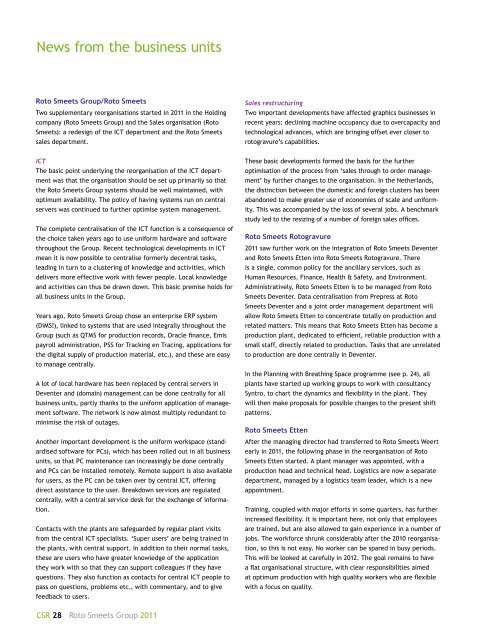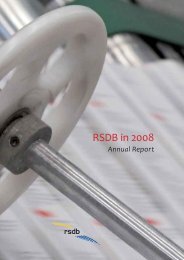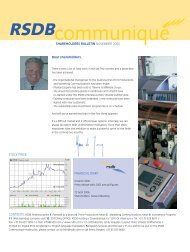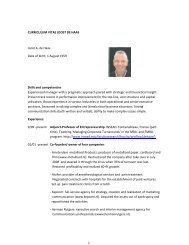Corporate Social Responsibility Report 2011 - Roto Smeets Group
Corporate Social Responsibility Report 2011 - Roto Smeets Group
Corporate Social Responsibility Report 2011 - Roto Smeets Group
Create successful ePaper yourself
Turn your PDF publications into a flip-book with our unique Google optimized e-Paper software.
News from the business units<strong>Roto</strong> <strong>Smeets</strong> <strong>Group</strong>/<strong>Roto</strong> <strong>Smeets</strong>Two supplementary reorganisations started in <strong>2011</strong> in the Holdingcompany (<strong>Roto</strong> <strong>Smeets</strong> <strong>Group</strong>) and the Sales organisation (<strong>Roto</strong><strong>Smeets</strong>): a redesign of the ICT department and the <strong>Roto</strong> <strong>Smeets</strong>sales department.Sales restructuringTwo important developments have affected graphics businesses inrecent years: declining machine occupancy due to overcapacity andtechnological advances, which are bringing offset ever closer torotogravure’s capabilities.ICTThe basic point underlying the reorganisation of the ICT departmentwas that the organisation should be set up primarily so thatthe <strong>Roto</strong> <strong>Smeets</strong> <strong>Group</strong> systems should be well maintained, withoptimum availability. The policy of having systems run on centralservers was continued to further optimise system management.The complete centralisation of the ICT function is a consequence ofthe choice taken years ago to use uniform hardware and softwarethroughout the <strong>Group</strong>. Recent technological developments in ICTmean it is now possible to centralise formerly decentral tasks,leading in turn to a clustering of knowledge and activities, whichdelivers more effective work with fewer people. Local knowledgeand activities can thus be drawn down. This basic premise holds forall business units in the <strong>Group</strong>.Years ago, <strong>Roto</strong> <strong>Smeets</strong> <strong>Group</strong> chose an enterprise ERP system(DiMS!), linked to systems that are used integrally throughout the<strong>Group</strong> (such as QTMS for production records, Oracle finance, Emispayroll administration, PSS for Tracking en Tracing, applications forthe digital supply of production material, etc.), and these are easyto manage centrally.A lot of local hardware has been replaced by central servers inDeventer and (domain) management can be done centrally for allbusiness units, partly thanks to the uniform application of managementsoftware. The network is now almost multiply redundant tominimise the risk of outages.Another important development is the uniform workspace (standardisedsoftware for PCs), which has been rolled out in all businessunits, so that PC maintenance can increasingly be done centrallyand PCs can be installed remotely. Remote support is also availablefor users, as the PC can be taken over by central ICT, offeringdirect assistance to the user. Breakdown services are regulatedcentrally, with a central service desk for the exchange of information.Contacts with the plants are safeguarded by regular plant visitsfrom the central ICT specialists. ‘Super users’ are being trained inthe plants, with central support. In addition to their normal tasks,these are users who have greater knowledge of the applicationthey work with so that they can support colleagues if they havequestions. They also function as contacts for central ICT people topass on questions, problems etc., with commentary, and to givefeedback to users.These basic developments formed the basis for the furtheroptimisation of the process from ‘sales through to order management’by further changes to the organisation. In the Netherlands,the distinction between the domestic and foreign clusters has beenabandoned to make greater use of economies of scale and uniformity.This was accompanied by the loss of several jobs. A benchmarkstudy led to the resizing of a number of foreign sales offices.<strong>Roto</strong> <strong>Smeets</strong> <strong>Roto</strong>gravure<strong>2011</strong> saw further work on the integration of <strong>Roto</strong> <strong>Smeets</strong> Deventerand <strong>Roto</strong> <strong>Smeets</strong> Etten into <strong>Roto</strong> <strong>Smeets</strong> <strong>Roto</strong>gravure. Thereis a single, common policy for the ancillary services, such asHuman Resources, Finance, Health & Safety, and Environment.Administratively, <strong>Roto</strong> <strong>Smeets</strong> Etten is to be managed from <strong>Roto</strong><strong>Smeets</strong> Deventer. Data centralisation from Prepress at <strong>Roto</strong><strong>Smeets</strong> Deventer and a joint order management department willallow <strong>Roto</strong> <strong>Smeets</strong> Etten to concentrate totally on production andrelated matters. This means that <strong>Roto</strong> <strong>Smeets</strong> Etten has become aproduction plant, dedicated to efficient, reliable production with asmall staff, directly related to production. Tasks that are unrelatedto production are done centrally in Deventer.In the Planning with Breathing Space programme (see p. 24), allplants have started up working groups to work with consultancySyntro, to chart the dynamics and flexibility in the plant. Theywill then make proposals for possible changes to the present shiftpatterns.<strong>Roto</strong> <strong>Smeets</strong> EttenAfter the managing director had transferred to <strong>Roto</strong> <strong>Smeets</strong> Weertearly in <strong>2011</strong>, the following phase in the reorganisation of <strong>Roto</strong><strong>Smeets</strong> Etten started. A plant manager was appointed, with aproduction head and technical head. Logistics are now a separatedepartment, managed by a logistics team leader, which is a newappointment.Training, coupled with major efforts in some quarters, has furtherincreased flexibility. It is important here, not only that employeesare trained, but are also allowed to gain experience in a number ofjobs. The workforce shrunk considerably after the 2010 reorganisation,so this is not easy. No worker can be spared in busy periods.This will be looked at carefully in 2012. The goal remains to havea flat organisational structure, with clear responsibilities aimedat optimum production with high quality workers who are flexiblewith a focus on quality.CSR 28 <strong>Roto</strong> <strong>Smeets</strong> <strong>Group</strong> <strong>2011</strong>






